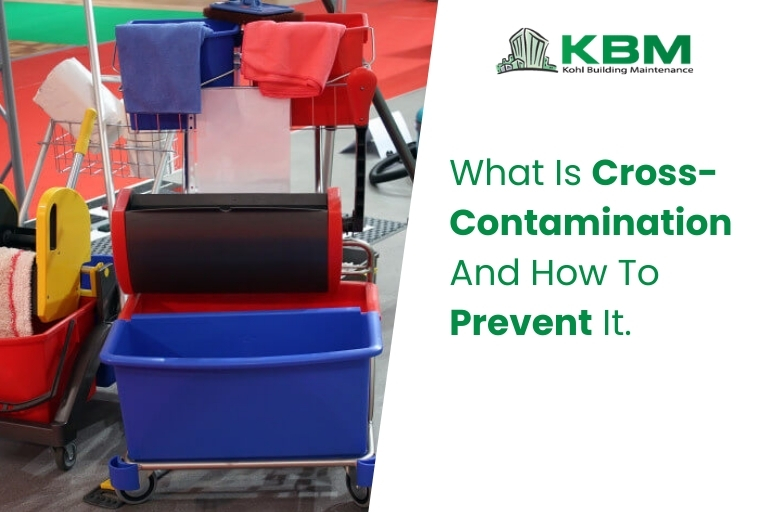Cross-contamination presents a significant concern across diverse environments, from healthcare facilities to foodservice establishments and even in our homes. Understanding what cross-contamination is and how to prevent it is important for upholding a safe environment. As a leading provider of commercial cleaning services and janitorial maintenance, Kohl Building Maintenance recognizes the importance of tackling this issue head-on. We’ll go through the concept of cross-contamination, its risks, and effective strategies to prevent it.
What is Cross-Contamination?

Cross-contamination occurs when harmful microorganisms, such as bacteria, parasites, or viruses, are transferred from one surface or substance to another. This transfer can happen through direct contact, airborne particles, contaminated utensils, or improperly cleaned equipment. In essence, cross-contamination introduces pathogens to areas or items that were previously free of them, increasing the risk of infection or foodborne illness.
Table of Contents:
Risks of Cross-Contamination
Cross-contamination poses significant risks in various environments, including:
- Foodservice: In restaurants, kitchens, and food processing facilities, cross-contamination can lead to foodborne illnesses. When raw meats, poultry, or seafood come into contact with food preparation surfaces or ready-to-eat foods, pathogens like Salmonella, E. coli, or Listeria can spread, causing food poisoning outbreaks.
- Healthcare Facilities: In clinics, hospitals, and other healthcare settings, cross-contamination can contribute to the spread of infections. Contaminated medical equipment, surfaces, or healthcare workers’ hands can transmit pathogens from one patient to another, leading to healthcare-associated infections (HAIs).
- Home Environments: Cross-contamination can also occur in households, especially in areas where proper hygiene practices are not followed. Shared utensils, cutting boards, or kitchen surfaces can transfer bacteria from raw foods to cooked foods, increasing the risk of foodborne illness.
Also Read: What Is The Difference Between Commercial Cleaning Services And Residential Cleaning Services?
How to Prevent Cross-Contamination
Preventing cross-contamination requires a combination of proper hygiene practices, effective cleaning techniques, and awareness. Here are some essential strategies to minimize the risk of cross-contamination:
- Separate Raw and Ready-to-Eat Foods: Keep raw meats, poultry, seafood, and eggs separate from other foods like fruits, vegetables, and cooked items. Use separate cutting boards, utensils, and storage containers to prevent cross-contact between raw and cooked foods.
- Practice Good Hand Hygiene: Thoroughly wash your hands with soap and water anytime you handle food before and after, using the restroom, or caring for someone who is ill. Hand hygiene is critical for reducing the spread of harmful bacteria and viruses.
- Clean and Sanitize Surfaces: Regularly clean and sanitize kitchen surfaces, countertops, cutting boards, and utensils to remove harmful pathogens. Use hot, soapy water for cleaning followed by a sanitizing solution or disinfectant to kill bacteria and viruses effectively.
- Use Proper Food Handling Techniques: Follow safe food handling practices, such as cooking food to the appropriate internal temperature, refrigerating perishable foods promptly, and avoiding cross-contamination during food preparation.
- Implement Color-Coded Equipment: In commercial kitchens or foodservice establishments, using color-coded cutting boards, utensils, and storage containers can help prevent cross-contamination. Assigning specific colors for different food groups (e.g., red for raw meat, green for vegetables) reduces the risk of mixing them up.
- Train Staff and Healthcare Workers: Provide comprehensive training to employees, food handlers, and healthcare workers emphasizing proper hygiene protocols, infection control measures, and the importance of preventing cross-contamination. Regular refresher courses can reinforce these principles and promote a culture of safety.
- Use Personal Protective Equipment (PPE): In healthcare settings, ensure that staff members use appropriate PPE. This includes gloves, gowns, and masks, to prevent the spread of infections. Dispose of used PPE properly to minimize the risk of contamination.
- Regularly Monitor and Audit Cleaning Practices: Conduct regular inspections and audits of cleaning practices in kitchens, healthcare facilities, and other environments prone to cross-contamination. Ensure that cleaning protocols are followed diligently, and address any deficiencies promptly.
Also Read: Top 10 Commercial Cleaning Trends For 2022
Conclusion
Cross-contamination poses significant risks in various settings, including foodservice establishments, healthcare facilities, and homes. By understanding the causes of cross-contamination and implementing effective prevention strategies, we can minimize the risk of infections, foodborne illnesses, and other adverse health outcomes. Whether in the kitchen, the hospital, or everyday life, practicing good hygiene, proper food handling techniques, and thorough cleaning procedures is essential for maintaining a safe environment free from harmful pathogens.
As a trusted provider of janitorial services in Los Angeles and surrounding cities, Kohl Building Maintenance is committed to helping businesses and organizations maintain clean, safe, and healthy environments. Contact Kohl Building Maintenance at 818-882-2600 today to learn more about our comprehensive commercial cleaning services and how we can help you prevent cross-contamination in your facility.
